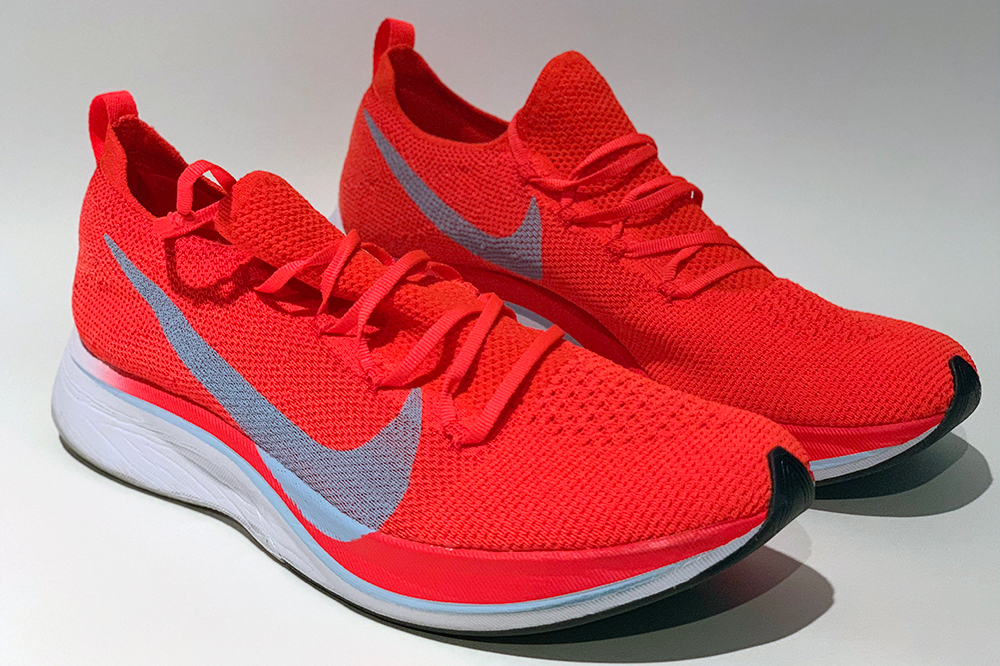
THE PROVERBIAL OTHER SHOE has dropped as WA issued its long-awaited ruling on Nike’s Vaporfly family of shoes (see “The $64,000 Question: ‘Is It The Shoes?’” from our October ’19 issue) on the last day of January.
The new protocol leaves the performance-enhancing shoes acceptable for competition, but clarifies the process for future shoes to be legal, as well as placing restrictions on the design of shoes. The rules, which take effect April 30, state that any shoe has to be available on retail for the public for at least 4 months before it can be used in competition. Prototypes are banned from competition.
That means that the Vaporfly prototype spikes that Sifan Hassan wore during her amazing display of distance prowess in Doha (1500/10,000 double) are now banned. The prototypes, which also raised complaints when Laura Muir wore them in breaking the British indoor mile record last winter, are not available to the public. It is not known yet if Nike is going to race them to the market so that its athletes can again compete in them 4 months later.
According to the guidelines, future shoe designs cannot have a sole higher than 40mm, the height of the current retail Next% (Nike’s pending Alphafly reportedly tops out at 50mm). Only one rigid plate is allowed in the insole (not including a spike plate). The guidelines do not affect jump shoes, which will continue to adhere to previous specifications, but spiked running shoes are limited to a 30mm sole. Spiked shoes may also have an additional plate, “but only for the purpose of attaching the spikes to the sole”
WA is establishing an expert working group to guide future research and implications in the shoe wars, and to assess new models. “It is not our job to regulate the entire sports shoe market,” said WA chief Seb Coe, “but it is our duty to preserve the integrity of elite competition by ensuring that the shoes worn by elite athletes in competition do not offer any unfair assistance or advantage. As we enter the Olympic year, we don’t believe we can rule out shoes that have been generally available for a considerable period of time, but we can draw a line by prohibiting the use of shoes that go further than what is currently on the market while we investigate further.”
The ruling won’t please some of the prominent voices that called for an outright ban on the Vaporfly and its variants. Some have responded in jest: Brooks runner Desi Linden tweeted, “BREAKING: @World Athletics rule all super shoes legal, with new requirement—athlete must wear a foam red nose while using said shoes during competition. Many regulations on the foam nose to follow, WA very actively testing models at the moment.”
BREAKING: @WorldAthletics rule all super shoes legal, with new requirement — athlete must wear a foam red nose while using said shoes during competition.
Many regulations on the foam nose to follow, WA very actively testing models at the moment. ? #itsjustajoke
— des_linden (@des_linden) January 31, 2020
Others have seriously mourned the fact that the records of the distance world—such as Paula Radcliffe’s long-standing marathon WR—are being erased too quickly. But the Alphafly is a step too far. When Bernard Lagat posted a photo of himself in what appeared to be Alphafly shoes, someone asked how much they would cost. One reply: “The price is integrity.”
Commentator Tim Hutchings tweeted, “I’ve huge admiration for much Nike has achieved & still does for our sport, but the Vaporfly shoes have made setting PRs & recordbreaking too easy for runners at all levels & it’s right it should stop. Our sport’s always respected history; these shoes don’t.”
I’ve huge admiration for much Nike has achieved & still does for our sport, but the Vaporfly shoes have made setting PBs & record breaking too easy for runners at all levels & it’s right this should stop. Our sport’s always respected history; these shoes don’t. #HollowPBsGalore https://t.co/42PlfxWirZ
— Tim Hutchings (@TimHutchings1) January 15, 2020
An analogy can be made to the switch to fiberglass poles for vaulting, though the effect of the Vaporfly doesn’t appear to be quite that extreme yet, and the effect of the new poles took many years to unfold, while the new family of super-shoes convey instant results. However, the shoes are so widely used now that the logistics of putting the genie back into the bottle were likely impossible.
That Vaporflys are now seen by many competitive distance runners as essential is undeniable. In Japan’s venerable Hakone Ekiden Relay, some 84% of the runners were clad in the Nikes, even those on teams sponsored by Mizuno and Asics. The following Monday, shares of the Japanese shoe companies dropped noticeably.
Reportedly, some of Nike’s competitors aren’t far behind in their design of racing shoes with similar features. Sharp-eyed observers at road races have spotted adidas prototypes that feature a thicker sole than the Vaporfly. And Brooks has announced the release of a new shoe that incorporates a carbon-fiber plate and new foam material.
The coming Olympic Trials Marathon, one can safely assume, will be a parade of Vaporflys mixed in with the new models of some of Nike’s competitors. Note that those competitors will need to hurry. In order for shoes to qualify as legal for the start of the Olympics on July 31, they need to be available on the retail market by the end of March.